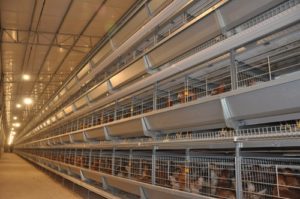Many people choose to raise chickens as their jobs. There are many kinds of chickens. They can decide whether to raise laying hens or broilers according to the characteristics of chickens and the conditions of farmers themselves. Both laying hens and broilers need chicken houses and poultry farming equipment. What management matters should be paid attention to when raising chickens in farms?
Drinking water sanitation, the most important thing to pay attention to is the sanitation of chicken coop drinking water, which cannot guarantee the sanitation of drinking water and directly affects the health of chickens. The core of influencing drinking water sanitation lies in water source, water storage, water tank, drinking water appliances, etc. All these must ensure sanitation, and drinking water can be sanitary.
Chickens are kept in chicken battery cages , and chickens are animals without sweat glands. The condition of chickens in cages should be observed in time. Chickens should be given different drinking water temperatures in summer and winter. The drinking water temperature in summer should be lower than the temperature to avoid sun exposure. If the water temperature is high, the amount of drinking water for chickens may drop significantly. Under cold weather conditions in winter, chicken farmers should provide warm water to the chickens, with the temperature of 15 degrees being the best, and the minimum should not be less than 5 degrees.

Laying hens fed in the breeding equipment during the peak egg production period drink the most water in three periods: 8: 00 a.m., 12: 00 noon and 6: 00 p.m. Therefore, these three time points must ensure that the chickens can drink water and sufficient water. The demand for drinking water for laying hens during the peak period of laying is not fixed, but needs to be adjusted according to the season and the actual feeding state of laying hens. In general, if the egg laying rate increases, drinking water needs to be increased. The amount of food consumed increases and the need for drinking water increases. Chicken farms that feed dry materials need to provide 2 times the amount of drinking water. When wet feed is fed to chickens, the amount of drinking water can be appropriately reduced. The amount of drinking water for each layer during the peak laying period is 200ml in spring and autumn, 280ml in summer and 110ml in winter.
When chicken farmers find that the amount of drinking water in the flock is decreasing, they should pay more attention, because this may indicate that the chicken is sick. However, if the amount of drinking water for chickens suddenly increases, it is often a manifestation of poisoning, such as salt poisoning. Therefore, chicken farmers should have a clear idea of how much food they eat and how much water they drink every day, and keep a good record so that they can have a complete answer. In the management of laying hens, it is quite common to wet the feed with drinking water, and it is impossible to completely avoid it. When chicken farmers find this situation, they should handle it in time: wet feed should be taken out and mixed with dry feed before feeding. If the wet feed has become sour or moldy, it should be taken out and thrown away, and the trough should be cleaned.